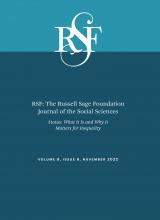Abstract
We argue that the properties of status hierarchies, independent of the positions actors occupy within them, have important effects on the degree of inequality in material rewards generated by status processes. We first discuss how a focus on status hierarchies differs from, complements, and extends the traditional focus on individual-level status positions. Drawing on a range of empirical case studies, we then identify three architectural features of status hierarchies—variations in their verticality, the clarity of their distinctions, and their rigidity—that affect the extent of inequality in the rewards received by the incumbents of high versus low status positions. We conclude by highlighting promising research questions and hypotheses that this macroscopic, status hierarchies approach raises.
- © 2022 Russell Sage Foundation. Accominotti, Fabien, Freda Lynn, and Michael Sauder. 2022. “The Architecture of Status Hierarchies: Variations in Structure and Why They Matter for Inequality.” RSF: The Russell Sage Foundation Journal of the Social Sciences 8(6): 87–102. DOI: 10.7758/RSF.2022.8.6.05. The authors would like to thank Hilary Holbrow, Annette Lareau, Chaeyoon Lim, Hazel Rose Markus, Cecilia Ridgeway, Lauren Valentino, and three anonymous reviewers for their careful reading and excellent comments on an earlier version of this article. Direct correspondence to: Fabien Accominotti, at accominotti{at}wisc.edu, Department of Sociology, University of Wisconsin–Madison, 8111 Sewell Social Sciences Building, 1180 Observatory Drive, Madison, WI 53706, United States.
Open Access Policy: RSF: The Russell Sage Foundation Journal of the Social Sciences is an open access journal. This article is published under a Creative Commons Attribution-NonCommercial-NoDerivs 3.0 Unported License.






